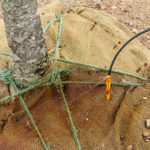Outstanding in our field

Ever wonder how Christensen’s stores and maintains trees in "the field" to keep them viable all year long? If you've ever tried to keep above-ground material healthy over a long period of time you know there are challenges to be met. But for the most part, it’s really not that far off from what you do when you plant a tree in a landscape - except we do it for a few thousand trees.
First, we grade out the area where the trees are going to go and then auger holes to place the trees in. After the tree is straight in the hole we backfill it with dirt and lightly pack it down.


Then an irrigation emitter is placed into every root ball. We use two different sizes of irrigation emitters, yellow for trees that are 3” or smaller and black for anything larger. We do an irrigation check on the trees at least once a week depending on the time of year. The irrigation system for the field might run 24 hours a day in the summer, so making sure that the trees get the required amount of water is sometimes difficult. We check the emitters to make sure they are not clogged, that they are spraying correctly, and that they haven’t come off of the feeder line and are flooding the tree.

After the trees are put in the ground we apply pre-emergent to prevent weeds from growing in the root balls and the surrounding soil. We generally do this twice a year. As the year goes on if weeds begin to grow we spray with non-selective herbicide. We add a non-toxic blue indicator dye to make sure that we are only hitting the targeted weeds and not the trees.

We do several other sprays throughout the year to prevent disease or insect damage. For instance, we spray for apple scab in the early spring as the trees just start to leaf out. There's also a scheduled spray to prevent gypsy moth, when the temperature is right. We do other targeted sprays as issues come up. Our nursery is inspected regularly for pests so we can be sure that our material is ready for distribution.

At the end of the season we put tree guards on the trunks to prevent damage that could be caused by roaming rabbits and deer. In the spring we remove any guards that are made from solid material in order to allow the trunk of the tree to stay dry and also to prevent bugs from making a home there.

Lastly, when we lift trees from the field to go on your truck, we carefully re-wrap the rootball with fresh burlap if needed. You can be confident that the trees we store are ready to go on your landscape job, spring, summer, or fall.

